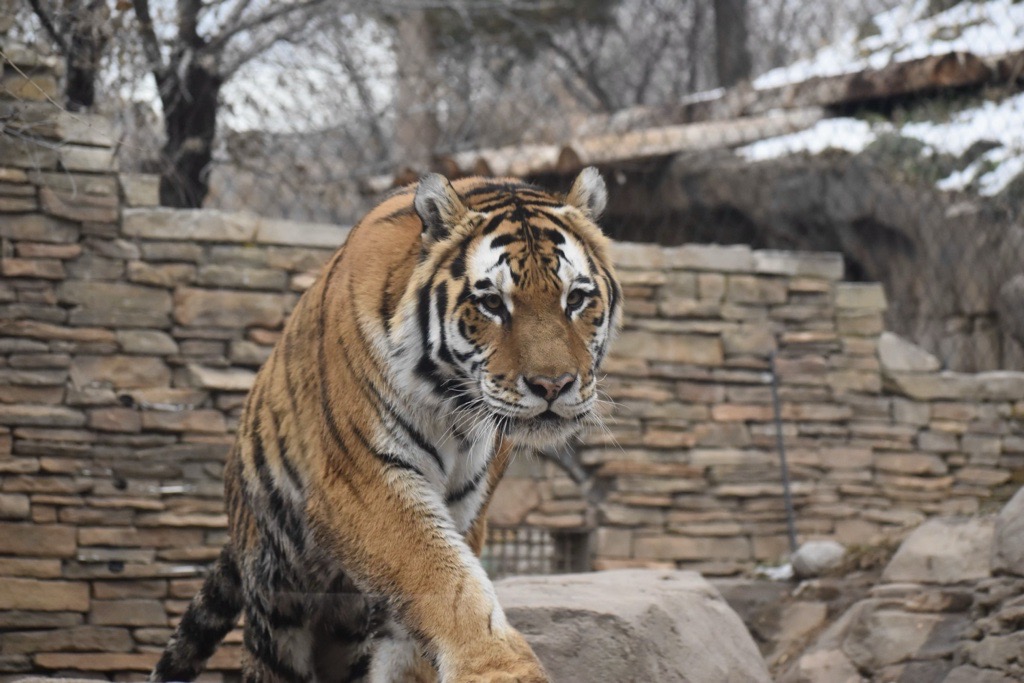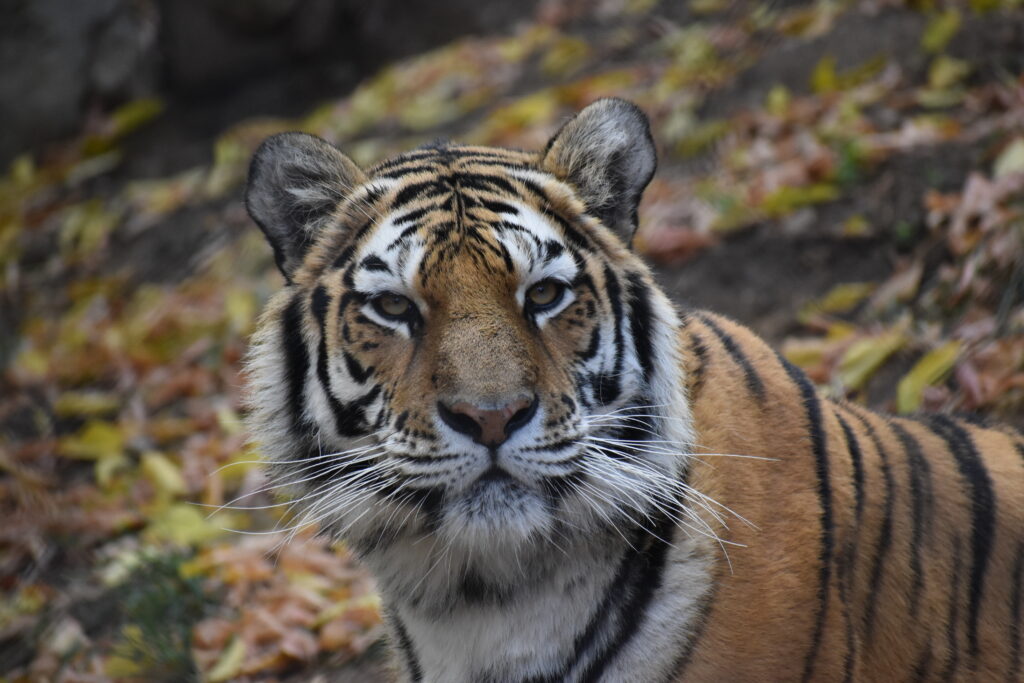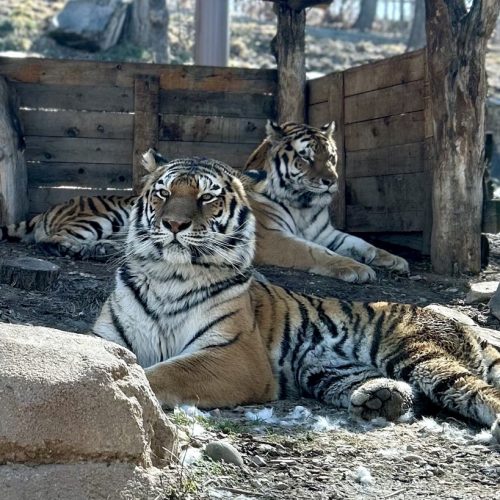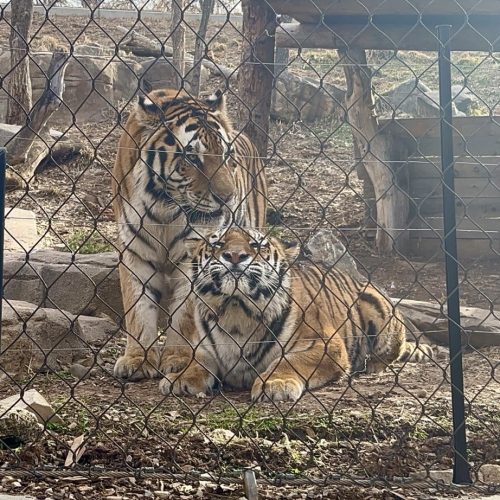

Tiger seasons: Introductions
and breeding at Hogle Zoo
Protecting the future of endangered species starts with the animals under our care. At Utah’s Hogle Zoo, we’re committed to helping the long-term survival of Amur tigers by facilitating resident tigers Nikolai and Sasha’s natural reproductive processes.
Nikolai, “Nik” (14) and Sasha (5) came to Hogle Zoo on a breeding recommendation from the Association of Zoos and Aquariums (AZA) Species Survival Plan (SSP). The tiger SSP coordinates breeding and oversees the husbandry and management of tigers to help maintain a genetically diverse, biologically healthy population of three tiger subspecies in AZA facilities, including endangered Amur tigers like Nikolai and Sasha.

Meet Nikolai
Nikolai, or “Nik” is an intelligent and observant tiger who enjoys interacting with his care team and exploring new enrichment.

Meet Sasha
Sasha is an expressive and vocal tiger who enjoys training sessions with her care team.
Through years of careful planning, dedication, and collaboration, our teams began introducing Nik and Sasha in early 2025 for breeding season. Since neither had met another tiger before and are solitary by nature, this process required extra care to ensure their comfort and safety.
Howdy, partner
Before tigers can safely share space, they first need to get to know one another in a controlled setting. To prepare for introductions, animal care teams work with each tiger individually, building their confidence and comfort in different spaces—such as swapping habitats.
Then, they begin ‘howdy’ introductions, a structured process where they can see each other through mesh barriers before having physical contact. This gradual approach helps ensure both tigers are comfortable before they fully share space. During a ‘howdy,’ our team watches for key behavioral cues that indicate the tigers are ready to be introduced.
Like other big cats, tigers experience an estrus phase when they are most receptive to breeding. Signs of the estrus phase include vocalizing to one another, seeking attention, cheek rubbing, and rolling on the ground.
An estrus cycle occurs roughly once a month, lasting about a week, with peak estrogen levels—and the highest likelihood of successful breeding—occurring over three days. Amur tiger breeding typically occurs from February through April but can happen year-round if tigers continue to show interest in one another and the female continues displaying signs of estrus.


Introductions
Every tiger has a unique personality and temperament, so our teams take their cues to create the best environment for a successful introduction. As naturally observant animals, tigers are highly attuned to their surroundings and quick to notice even the smallest changes! Sasha and Nik have shown us they’re most comfortable with familiar keepers and staff nearby, especially in situations outside their normal routine.
During this process, Asian Highlands closes to give Sasha and Nik a quiet, comfortable space to get to know one another in their outdoor habitats. Limiting disruptions also allows our team to closely observe their interactions. Our animal care team looks for positive signs like:
- Chuffing
- Vocalizations
- Rolling on the ground
- Resting near each other
- Successful mating
During introductions, guests may experience periodic closures of Asian Highlands and may hear vocalizations.
Animal care in action
Introducing any pair of animals requires thoughtful planning, preparation, and team collaboration, but this is especially true for apex predators like Amur tigers. It’s common for tigers who are introduced to have disagreements or spats with each other as they learn to share space. They may display aggressive behaviors such as swatting or roaring to set boundaries and communicate their need for space. Our animal care and health teams watch closely to see what boundary-setting behavior is and if the behavior is more than that.
This aggressive behavior can lead to injuries and even fatalities. Our focus is on preparedness – our teams are prepared and equipped to handle these scenarios. We have tools, such as CO2 canisters, a leaf blower, air horns, and other loud sounds, to separate the tigers if they become too aggressive.
Everything the keepers do during tiger breeding introductions is based on the tigers’ behavior and communication with each other, their keepers, and the environment. Each step of the process is designed to prioritize the wellbeing and safety of both tigers.
See breeding season updates:
What comes next?
Breeding season is driven by the tigers. If Sasha continues showing signs of estrus and both tigers remain interested, introductions may continue monthly—it will depend on Sasha!
So far, Sasha and Nik have shown encouraging signs, vocalizing to one another, resting near each other, and demonstrating positive behaviors that indicate comfort in shared space. This first step is a major milestone for the tigers and our team, marking months of planning, hard work, and dedication.
If breeding is successful in the future, Sasha would move behind the scenes for about three months during pregnancy and stay there afterward for a short period to care for potential cubs in a quiet, comfortable environment.
Tiger introductions and breeding are guided by the tigers’ needs and choices. Our teams take this process one step at a time, remaining cautiously optimistic, and are prepared to help the tigers thrive in whatever situation they show us is best for them.
Stay tuned for future updates and be sure to visit Sasha and Nikolai in Asian Highlands.

